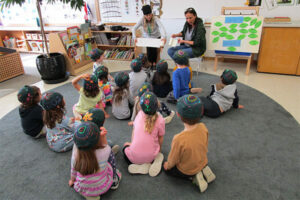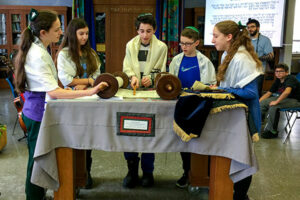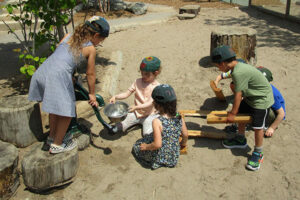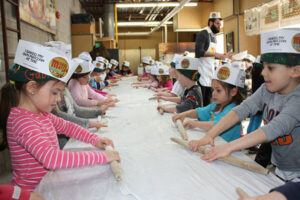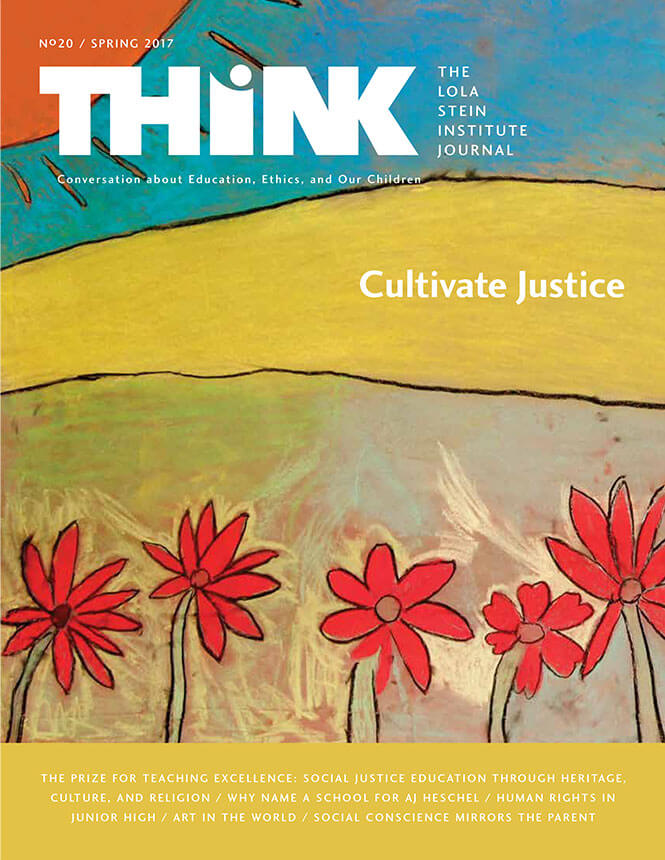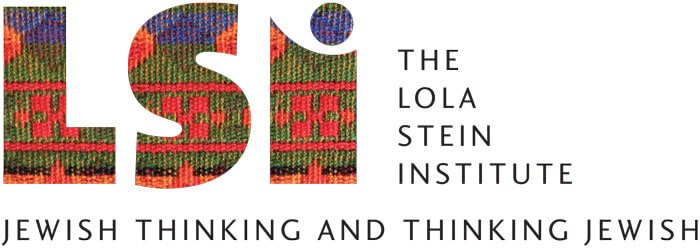- How We Teach

- First Column
- Second Column
- Third Column
- Case Studies

- First Column
- Second Column
- Culture & Community

- First Column
- Second Column
- News & Views

- Admissions

- First Column
- Second Column
- Support Us

- About

- First Column
- Second Column
- Parent Hub
- Attend an Open House
- Take a Tour
- Donate Now
- Calendar
- Blog
- 416-635-1876
- Search
The Toronto Heschel School: A Good Name
by
Rabbi Shimon said, “There are three crowns: the crown of Torah, the crown of priesthood, and the crown of kingship. And the crown of a good name is superior to them all.”[1] In 1996, the founders of a new Jewish Day School in Toronto sought “a good name,” for their school, a name to symbolize the special kind of Jewish education they envisioned for their children. The school would offer a values-driven education, rooted in the teachings of Judaism, and aspire to graduate responsible caring citizens.
The crown of Torah stands for learning; the crown of priesthood stands for ritual and prayer; the crown of kingship stands for justice and fair rule. A good name refers to a person who integrates all of these virtues. The school founders chose to name the school after Rabbi Dr. Abraham Joshua Heschel.
Rabbi Heschel was an innovative Jewish thinker and courageous Jewish leader. His life exemplified the integration of Jewish learning, Jewish ritual, and social justice. Steeped in the Hassidic traditions of Eastern European Jewry, while masterful in modern scholarship and philosophy, Heschel was simultaneously a traditional, observant, learned teacher and an outspoken, ground breaking political and social activist.
Heschel lost most of his extended family during the Shoah, barely escaping himself. In America, he involved himself in the Civil Rights Movement, the Anti-Vietnam War movement, and the struggle to free Soviet Jewry. He advocated for Jewish pluralism, while holding fast to his own traditional practice. He wrote numerous books of theology in eloquent, inspiring prose.
As a member of the Toronto Heschel School community for over 20 years, I have been incredibly inspired by Rabbi Heschel’s spiritual teachings and social activism. The big question for me, after all these years, is how these two aspects of Heschel’s work relate to one another. How, for Heschel, do Jewish spirituality and religion connect to social justice and responsible citizenship? And, most critically, what does this mean for teaching Jewish children?
From an educational perspective, Heschel’s most important teaching on knowledge is his notion of wonder, radical amazement and awe. Heschel writes:
Wonder, not doubt, is the beginning of knowledge…Our goal should be to live life in radical amazement… [We should] get up in the morning and look at the world in a way that takes nothing for granted. Everything is phenomenal; everything is incredible; never treat life casually. To be spiritual is to be amazed.[2]
Heschel’s insight that wonder is the doorway to knowledge is a powerful invitation for educators to embrace theories of learning that encourage curiosity, discovery, and imagination. When Heschel says, “To be spiritual is to be amazed,” he reminds us that we experience God when we appreciate how every aspect of the world is amazing, even our own minds. Amazement is not a naive, pre-rational condition; rather, it is the highest form of perception. Amazement and wonder allow us to be aware of the “ineffable,” that which we cannot grasp by rational thought alone. Wonder is not just the beginning of Jewish knowledge, but of all knowledge. Maurice Friedman, an eminent Heschel scholar, observes that for Heschel, “insights into the ineffable are ‘the root of man’s creative activities in art, thought, and noble living,’”[3] a profound meta-cognitive worldview that educators should encourage and refine in their students.
Heschel’s concept of wonder reveals an alignment between ancient Jewish sources and progressive educational theories today. Multiple intelligence theory, arts-based learning, and constructivism regard children as dynamic, creative thinkers and encourage these proclivities. Heschel also shows us how Judaism has its own ways of teaching that awaken wonder and nurture amazement.
The most powerful of these may be prayer, which Heschel emphasizes as a vehicle to identify, acknowledge, and appreciate the wonder of our very existence—in it all its joys and sorrows. Prayers are songs that express our passion and amazement: “The primary purpose of prayer is not to make requests. The primary purpose of prayer is to praise, to sing, to chant. Because the essence of prayer is a song, and man cannot live without a song.”[4] While wonder and radical amazement are essential as the “beginning of knowledge,” and prayer serves them well, for Heschel they are not the only, or even the most important way a Jewish person relates to God. Later in life, Heschel delved into the prophetic tradition of Judaism, for which a relationship with God depends urgently on acts of social justice. From the prophets Heschel learned that, “Whatever I do to man, I do to God. When I hurt a human being, I injure God…The secret of our legacy,” he wrote, is “that God is implied in the human situation and that man must be involved in it.”[5]
Studying the prophets of Israel led Heschel to become increasingly active in the Civil Rights Movement, in the Anti-Vietnam War Movement, and in the struggle for Soviet Jewry . After marching from Selma to Montgomery with Reverend Martin Luther King Jr. and other religious leaders, Heschel declared, “I felt my legs were praying.”
One of the most valuable gifts Heschel offers Jewish educators is to show how Judaism and Jewish sources speak to relevant social issues in each generation. In his opening address to the National Conference of Christians and Jews in January 1963, Heschel drew a stark parallel between the Exodus narrative of the Torah and the Civil Rights movement:
“At the first conference on religion and race, the main participants were Pharaoh and Moses. Moses’s words were, ‘Thus says the Lord, the God of Israel, let My people go that they may celebrate a feast to me.’ While Pharaoh retorted: ‘Who is the Lord, that I should heed this voice and let Israel go? I do not know the Lord, and moreover I will not let Israel go.’ The outcome of that summit meeting has not come to an end. Pharaoh is not ready to capitulate. The Exodus began, but is far from having been completed. In fact, it was easier for the children of Israel to cross the Red Sea than for a Negro to cross certain university campuses.“[6]
At the Toronto Heschel School, we follow Heschel’s model and continuously draw our students’ attention to how Jewish sources speak to relevant social responsibility and social justice concerns. One Grade 5 integrated project asks students to match text from Exodus with passages from the novel Underground to Canada. A year-long Grade 8 human rights curriculum brings text from Sefer Devarim (Deuteronomy) and the Talmud to address discrimination, child labour, and gender inequality today.
Every year I come to understand the connection between these two key aspects of Heschel’s thinking, between perceiving awe and wonder in the world and engaging in acts of social justice. Every year I feel that I understand a little more why awe and wonder matter for social justice.
Through the lens of awe and wonder we see how amazing the world is, how incredible, complex, and unique each human being is. We are driven to notice and feel concern for life and for the quality of each person’s life. We realize that everyone should experience the fullness of the world’s wonders, that no child should be deprived of meaningful education, that no human life wasted through war and poverty, and that no one should have to live with shame or fear. A state of awe and wonder leaves us realizing what really matters. We focus on the essential and disdain the trivial.
The lesson for educators is this: If children habituate to learning by rote – whether in math class, Torah class, or elsewhere— they meet life as rote and set. Their moral imaginations narrow and their sense of the possible remains limited to what already is. Conversely, when children habituate to learning through awe and wonder – whether in math class, Torah class, or elsewhere— they meet life as full of surprise and possibility. Their moral imaginations are more open to embrace what they value as feeling and searching individuals and as Jews. Their sense of the possible expands to see that social injustice— discrimination, prejudice, and poverty— is not inevitable but entrenched by narrow, spiritless thinking. Awe and wonder inspire in students the desire to expand the awe and wonder in the world, for themselves and for others.
Teaching through awe and wonder creates the habits of heart and mind that inspire the work of social justice. Prayer not only reveals and expresses our amazement at the world. Prayer, writes Heschel, also “clarifies our hopes and intentions. It helps us discover our true aspirations, the pangs we ignore, the longings we forget…words of prayer are commitments, We stand for what we utter… prayer teaches us what to aspire to…the idea becomes a concern, something to be longed for, a goal to be reached, when we pray.”[7]
The ancient rabbis debated whether learning or action is more important; they concluded that learning comes first, because it leads to action. Linking Rabbi Heschel’s concept awe and wonder to social action, we see how the rabbinic equation works. Learning, which inspires awe and wonder and clarifies our aspirations, leads to action to redeem the world from pettiness and selfishness.
Rabbi Heschel’s life was a model of this integration. His is a “good name” for an inspired vision of Jewish education. His is the good name that we, at The Toronto Heschel School, strive to emulate.
[1] Mishna, Pirkei Avot 4:17
[2] Heschel, A.J. Man is not alone. New York: Farrar, Strauss, Giroux, 1951.
[3] Friedman, Maurice. Abraham Joshua Heschel & Eli Wiesel: You are my witness. New York: Farrar, Strauss, Giroux, 1987 (page 44).
[4] Heschel, Susannah, Ed. Moral Grandeur and Spiritual Audacity. New York: Noonday Press, 1996, page 397.
[5] Heschel, A.J., The Plight of Russian Jews,” United Synagogue Review, 1964
[6] National Conference of Christians and Jews entitled “Religion and Race,“ Opening address, January 1963
[7] Heschel, A.J. I asked for wonder. New York: Crossroads Publishing, 2006.
Greg Beiles , Director of The Lola Stein Institute and Head of School of The Toronto Heschel SchoolGreg Beiles became Director of the Lola Stein Institute in 2010 and Head of School at the Toronto Heschel School in 2014. For the 18 years prior to being named Head of School, Greg worked and taught at the school is increasingly senior capacities. From 2008 to 2010 he also served as Director of Curriculum and Training at the Lola Stein Institute.
Greg holds an MA in the Philosophy of Education from The Ontario Institute for Studies an Education and is a PhD Candidate at the Centre for the Study of Religion, both at the University of Toronto. His research explores a re-framed vision for Jewish education.
Greg’s publications include “Jewish education and pluralistic engagement”, in Discipline, Devotion and Dissent: The promise and problems of Jewish, Catholic and Islamic schooling, ed. G. McDonough, M. Memon, and A. Mintz. In the PEJE publication, Jewish Day School Education, he published “And you shall love your God.” His column “Awe and Wonder” appears regularly in think magazine; his titles include; “What Makes a School Jewish?” and “Education for the Next Generation: Thinking in the Disciplines.” Greg has led workshops and presentations in a variety of settings, including The Bridges Conference at the Banff, York University, the Jewish Federation of Ottawa, and the Lola Stein Institute, A few workshops titles include: A Critical Thinking Approach to Numeracy; Five senses and the Five Books of Moses; Metaphor and God; Understanding Understanding; Discipline & Wonder: Integrating the Theories of A.J. Heschel and Howard Gardener in an Educational Context.
NEXT ARTICLE
Learning to Solve Real Problems at Ages 4 and 5Special Feature
Second PrizeTodd Clauer: Upper School Social Justice ProjectFirst PrizeErin Buchmann: Indigenous AwarenessA Report by Ruth BurnsteinThe Prize for Teaching Excellence 2016What Do We Have in Common?Finding the Familiar in Grade 2Our Sages Tell Us
A Mirror Reflection of UsThe Social Conscience of Our ChildrenColumns
An Interview with Dana EzerThe Jewish Foundations of a Junior High Human Rights CurriculumRecommendations for Children and the People Who Love ThemGood Books by Gail BakerPerspectives
 The Lola Stein Institute (LSI) is a centre of inventive educational thinking and addresses the challenge to re-frame schooling for the exigencies of our times.
The Lola Stein Institute (LSI) is a centre of inventive educational thinking and addresses the challenge to re-frame schooling for the exigencies of our times.

